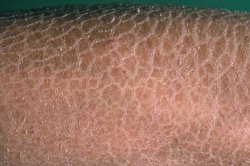X-linked recessive ichthyosis (vulgaris)
|
|
|
 |
X-linked recessive ichthyosis - in the English and American literature the term vulgaris is usually no longer part of this diagnosis - is the second frequent ichthyosis and has in Caucasian populations such as Denmark a prevalence in the general population of 1 in 4.000. The disease is X-linked which means it is usually present only in the male sex. Women can be conductors of the deficient gene but apart from an insignificant scaling perhaps on the lower legs they are usually spared. This type of ichthyosis starts in infancy most often around 3 to 4 months. In the beginning on the lower legs the first symptoms are a rather light scaling resembling that of ichthyosis vulgaris. With increasing age the scaling gets darker and becomes more adherent and later can become dark brown, thick and again show a rhombic appearance reminding of many fields covering the body. Very often the big body folds such as the antecubital fold and the popliteal fold are also spared or show a minimal involvement only. In contrast to what is found in ichthyosis vulgaris the palms and soles show no accentuated creases. A further finding may be occasional alterations of the cornea of the eye which usually cause no clinical troubles. Moreover, 1 in 5 of affected boys suffer in childhood from a maldescent of the testes (cryptorchidism). This testicular maldescent - if not properly treated - can result in severe clinical problems such as hypogonadism and in extreme cases even hypogenitalism. Occasionally other diseases such as the Kallman syndrome featuring hypogonadism and an inability to smell ("anosmia") are associated due to complex deletions on the X-chromosome.
The biologic mechanisms underlying this X-linked recessive type of ichthyosis vulgaris are well known today. The gene for this disease is located on the short arm of the sex chromosome the so-called X-chromosome. On the X-chromosome a gene is encoded for an enzyme having the name steroidsulfatase. If a mutation occurs in this gene or if the entire gene is deleted, the resulting steroidsulfatase enzyme becomes deficient. This enzyme is necessary for the removal of sulfate from cholesterol. Thus the scales of patients with X-linked ichthyosis contain much elevated levels of cholesterol sulfate and the ratio between cholesterol to cholesterol sulfate is disturbed with a shift of the balance to cholesterol sulfate. Cholesterol sulfate can inhibit proteases which are necessary to dissolve so-called corneodesmosomes which connect neighbouring keratinocytes (corneocytes). These enzymes are among else stratum corneum chymotryptic enzyme and stratum corneum tryptic enzyme and they work slower in dissolving the connections (corneodesmosomes). The result is that the normal desquamation of the skin is disturbed. Therefore this type of ichthyosis is also considered a "retention" type of keratosis meaning that the scales are more adherent to each other and are retained on the skin for a longer time.
The activity of the underlying steroidsulfatase enzyme can be determined by a functional assay in the blood so that this type of ichthyosis can be rapidly diagnosed by a simple analysis of a blood sample.
The disease is present in the male sex only as men have only one X-chromosome and their second sex chromosome is the Y-chromosome. Thus men lack a second X-chromosome which is present in women and therefore genetic defects on their X-chromosome cannot be compensated. In contrast women who have two X-chromosomes can compensate mistakes in the genes (mutations) on one X-chromosome by the action of the flawless second X-chromosome. Therefore they are more or less spared from the disease but can transmit the deficient gene to their sons.